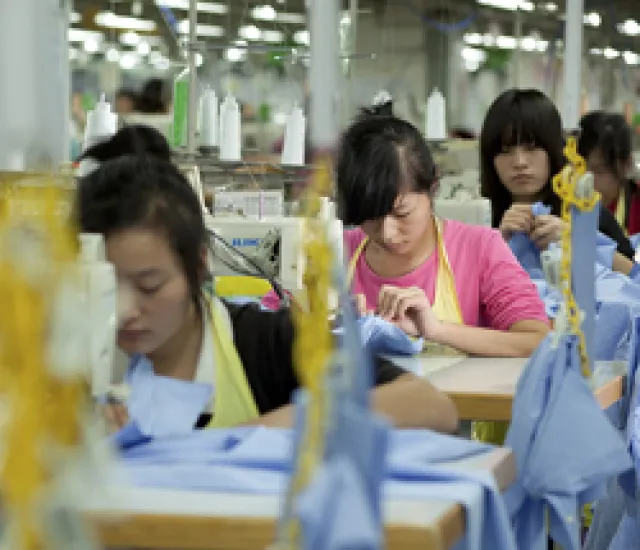For all its spectacular growth in the last decade, China has an economy in rapid transition – from an export-driven economy to one driven by internal needs and demand. Investors who can recognize the change and act on it now may benefit even more than China investors in 2009, when the country’s economy grew by 8.7 percent and its gross domestic product total was $4.9 trillion.
“Our analysis suggests that China’s outperformance is poised to continue and we remain overweight China,” says Richard Ross, global technical strategist with Auerbach & Grayson, a New York brokerage firm that specializes in global stocks.
[Click here to access the complete rankings of the 2011 All-China Research Team and read the profiles of the region's Top Analysts].
China is the world’s most populous nation and the largest player in the BRIC (Brazil, Russia, India and China) universe. Its’ GDP growth is among the fastest of the world’s major economies. It’s a nation that has built its growth without the kinds of leverage that has been so characteristic of growth of western economies. And its trade surplus of $3 trillion is causing many to see it as the next global superpower, eclipsing even the US.
The global economy now is bifurcated between the emerging markets and the developed markets, with more and more assets — equities and fixed income — being allocated to the emerging markets. Morgan Stanley, for example, expects the inflows into the emerging markets to exceed $1 trillion annually. “Given the extent to which this is likely to lead to foreign exchange reserve accumulation, this trend to a strong pull upwards for emerging market assets,” writes Morgan Stanley’s Rogerio Oliveira. What country is the greatest beneficiary of this asset allocation? China.
Still, there is also a lot of bearish sentiment that has suddenly overtaken the optimism surrounding China. Inflation in China could undo many of the strides that the economy has made, the bears say. They point to the slowing down of the economy and to the housing bubbles that are about to burst.
The recent purchasing managers’ index, a key gauge of manufacturing growth fell to 52 in May, down 0.9 from 52.9 in April. While the drop is an indication that the economy is slowing down, the economy is still in an expansionist mode, analysts point out. The slowdown only becomes worrisome if the index drops below 50. And that may be a long way away.
“What you are seeing is an economy in transformation,” says William Kaye, senior managing director of the Pacific Group, a Hong Kong-based investment manager. China’s growth has been driven by its exports. But as the global economy flounders, and growth slows down, China is looking internally to continue the growth. It plans to control its own destiny.
Kaye, who has been investing in Chinese companies and firms with significant China exposure since the 1990s, points out that China works top down. In recent months, the Chinese government has managed to keep interest rates up, force the banks to reduce their lending and introduce laws to cool down the housing market.
There also is an attempt to shed its image as the low-cost provider of labor, notes Kaye. Until now, the Chinese have been willing to subsidize labor costs to provide low-cost manufacturing facilities to foreign companies. Now they are quite willing to withdraw those subsidies and let the plants close down. Stricter minimum wage regulations and a willingness to shift some of the manufacturing to meet domestic demand also means that some of these low labor cost manufacturing may have to shut down. “What you are seeing is not an economy in trouble, but a reallocation of resources,” says Kaye. And that doesn’t always sit well with some analysts.
“The new growth in the economy will be driven by enormous government investment and spending on infrastructure,” says Robert Raucci, a managing partner of Newlight Associates, a New York investment firm. And the domestic industrial infrastructure — power generation, clean energy, water processing — is the most likely to benefit.
But there’s also been a fundamental change in what the Chinese citizens earn and where they live. More than 600 million live in China’s cities, and as many as 500 million have been lifted out of poverty. Not only is there an increased demand for food but also for different kinds of food. The nature of China’s consumption is changing, says Raucci. And that means that the technology sector – wireless, software, semiconductors – will also be a major beneficiary.
There are pitfalls. The Chinese seem to have little respect for intellectual property issues or, for that matter, financial disclosure and transparency. In recent months several exchanges have barred trading in Chinese companies because of alleged irregularities and less than complete disclosures. In January, the Hong Kong exchange suspended trading in China Forestry after its chief executive was arrested for alleged embezzlement of $4.6 million. Subsequently, other exchanges including NYSE and Toronto have suspended trading in more than a dozen Chinese companies that are said to be in violation of disclosure laws.
Some of these problems are symptomatic of growth markets, especially where companies issue a surge of listings to take advantage of investor interest. But these are inefficiencies that can produce attractive investments if investors are willing to act locally, take time to understand the environment in which these companies operate. “Think local, act local,” says Raucci.
China is still a compelling story, says William Kaye. “It is still the country that accounts for most of today’s global growth.” And what passes for problems may well be part of a plan to reallocate resources against the conventional thinking. You’re looking at a country that has gotten so far based on exports and now has decided to take a different direction. That direction may make investing in China even more attractive than the past.






